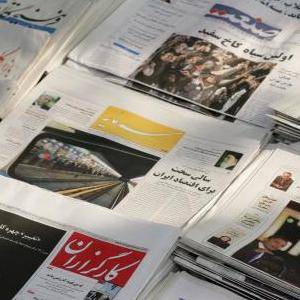Tehran's Daily Newspaper Review

Iran daily chose another optimistic headline to emphasize the boom in the Iranian economy. The newspaper reported of privatization of governmental agencies worth of 84 billion dollars and “the unprecedented participation of the private sector in the national economy”. A couple of days after Ayatollah Khamenei’s meeting with the cabinet, in which the Iranian Supreme Leader made several –though mild- criticisms of the government- Iran reported of “the government’s special attention to the Leadership’s concerns”.
Jomhouri-ye Eslami focused on the quest for 50 thousand prisoners of Qaddafi in Libya, citizens which were detained during the uprising of the Libyan people during the recent months. Opening of the reservoir Agh Chai dam in the Western Azerbaijan province was also covered by the newspaper. In its editorial, Jomhouri-ye Eslami warned about Western countries craving to satisfy their oil interests in Libya, while it also slammed Qaddafi, a “clown” who could foresightedly taken with himself his billion dollar assets to live his “animal-like life” in another country.”
Kayhan quoted head of the Libyan Military Council saying that there are no doubts about the Islamic nature of the Libyans’ revolution. The Bahrainis believe that Al-Khalifah’s promises are lies and the monarchy should relinquish power according to Kayhan. In the newspaper’s editorial, Kayhan advised the government’s critics for compromising fairness when speaking of the government’s imperfections and providing “feed for the foreign media”. While tribalistic political behavior has blinded some towards the government’s achievements, preferential treatment stops some of its supporters from admitting the defects Hossein Shari’atmadari argued. He also criticized the government for its impatience towards criticisms.
Resalat’s top headline was a quotation from head of Iran's National Atomic Energy Organization Fereydoun Abbasi who stated that Iran is ready to provide nuclear fuel for other countries. Resalat’s eulogistic editorial was authored by Mahmoud Farshidi, minister of education in Ahmadinejad's first administration, on the life of Mohammad-Javad Bahonar, minister of education in the early months of 1979 Revolution and later the prime minister, who, along with President Rajaei was killed in an explosion in August 1981.
The astounding 3 billion dollar embezzlement still appears on the front page of newspapers. Shargh quoted head of the General Inspection Organization Mostafa Pourmohammadi who claimed his organization had warned the banking network about the possibility of a major embezzlement. Shargh also quoted Foreign Ministry Speaker Ramin Mehmanparast who rejected allegations of IRGC’s Quds Division taking part in Syria’s developments.
Former coach of the Iranian national soccer team Miroslav Blazevic was banned by the Iranian Football Federation from directing a local team according to a law which rules out +65 football managers from taking helm of soccer teams. Tehran-e Emrooz re-focused on the ban on public announcement of the inflation rate by the government. Principlists’ unity may turn into a chimera as members of the newly formed “Resistance Front” –mainly consisted of Ahmadinejad's former ministers- have fallen at odds with Ayatollah Mahdavi Kani believing to be underrepresented in the 7+8 mechanism which is assigned with drafting a slate for the parliamentary election. Tehran-e Emrooz’ editorial also focused on the government’s grimace at criticism and its poor relations with the academic elite in the field of economy.
The Supreme Leader’s speech in meeting with the cabinet was called “the government’s jihadi charter” by Vatan-e Emrooz, jihad used in its extensive sense, i.e. a religious duty which is/should be followed zealously by a Muslim. The Irene hurricane, Tehran's air pollution and liquid subsidies were also covered by the newspaper.
Iranian newspaper won’t publish on Wednesday and Thursday, the Eid-e Fetr holidays.
* Note: Vatan-e Emrooz does not publish on Thursdays.
Trouble with understanding some terms? Check our Glossary of Iranian Political Terms.
Briefing
Hamshahri (Citizen) is the official daily newspaper of Tehran's Municipality. Its general directions in politics, culture and economy are determined by the mayor of Tehran, currently Mohammad Baqer Qalibaf.
Iran is the official organ of the administration.
Jomhouri-ye Eslami (The Islamic Republic) was known as the official organ of the Party of the Islamic Republic, founded in 1979 and disbanded in 1987. Currently, it is an open critique of Mahmoud Ahmadinejad's policies and is known to be a mouthpiece of Akbar Hashemi Rafsanjani.
Kayhan (Universe) is a hard-line conservative newspaper. Its editor-in-chief –currently Hossein Shari’atmadari- is appointed by Iran's Supreme Leader. Shari’atmadari’s editorials often spark off controversy and debate inside Iranian political circles.
Khabar (News) is a principlist daily newspaper which adopts a critical stance towards Ahmadinejad's policies.
Resalat (Mission) belongs to the moderate wing of the principlist camp. Resalat’s best known analyst is Amir Mohebbian, its political editor.
Shargh (East) is a moderate reformist newspaper. It was the most popular and influential reformist newspaper in its first period of publication which lasted from August 2003 until September 2006.
Tehran-e Emrooz (Tehran Today) is a ‘principlist reformist’ newspaper, connected to Mohammad Baqer Qalibaf.

